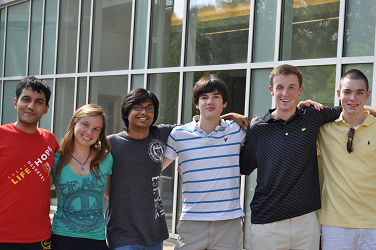Team:GeorgiaTech/Project
From 2011.igem.org
(→Overall project) |
(→The Experiments) |
||
| Line 75: | Line 75: | ||
=== The Experiments === | === The Experiments === | ||
| - | |||
| - | |||
=== Part 3 === | === Part 3 === | ||
Revision as of 21:21, 15 July 2011
| You can write a background of your team here. Give us a background of your team, the members, etc. Or tell us more about something of your choosing. | |
|
Tell us more about your project. Give us background. Use this is the abstract of your project. Be descriptive but concise (1-2 paragraphs) | |
| Team Example |
| Home | Team | Official Team Profile | Project | Parts Submitted to the Registry | Modeling | Notebook | Safety | Attributions |
|---|
Contents |
Overall project
Overuse of antibiotics in medical settings has created the problem of extremely antibiotic resistant bacteria, also called “super bugs,” which develop through the process of horizontal gene transfer of plasmids. The experiment outlined in this proposal intends to engineer a unique method of “reverse” vaccination in which the plasmid containing an antibiotic resistance gene is specifically targeted and destroyed, rendering the bacteria vulnerable to antibiotic treatment. The novel method we are developing utilizes a CRISPR system (Clustered Regularly Interspaced Short Palindromic Repeats) contained on a separate plasmid to inactivate the foreign DNA[1].
The CRISPR system is a type of immunity used by about 40% of Bacteria and about 90% of Archaea [3]. It consists of a series of proteins, called cas proteins, which are associated with a series of “spacers” separated by short palindromic sequences, that recognize foreign DNA (either plasmid or viral). If foreign DNA is recognized, the cell “chops” up the invading DNA. If the DNA is not recognized and the cell survives the infection, it then “saves” pieces of the foreign DNA in subsequent spacers, to be used in future recognition of an attack (Figure 1)
Figure 1: Diagram of the mechanism of CRISPR, including steps of acquisition of DNA from an infecting virus, integration of DNA into the host chromosome, expression from the CRISPR locus and targeting and inactivation of viral DNA (diagram reproduced from [2]).
We will be creating a shuttling vector with the CRISPR system and using this modified CRISPR system that is delivered via a viral or plasmid vector. Our research aims to demonstrate that antibiotic resistance genes can be targeted with the same CRISPR system in multiple bacterial species, rendering the bacteria more susceptible to treatment. Specifically, artificial kanamycin resistance in a non-pathogenic S. thermophilus DGCC7710 strain will be targeted by using a CRISPR system that has a kanamycin resistance plasmid spacer. In addition, our hope is to develop computer modeling approaches to be used for understanding CRISPR spacer uptake. Ultimately, new ways for targeting antibiotic resistance will be realized, helping to spark further research and innovation in this subject and CRISPR systems with real world applications.
References:
[1] Babu, M., N. Beloglazova, et al. A dual function of the CRISPR–Cas system in bacterial antivirus immunity and DNA repair (2011). Molecular Microbiology 79(2): 484-502. [2] Horvath P., Barrangou R., CRISPR/Cas, the immune system of bacteria and archaea (2010). Science, 327(5962), 167-170. [3] Barrangou, R., C. Fremaux, et al. CRISPR provides acquired resistance against viruses in prokaryotes (2007). Science, 315 (5819), 1709-1712
 "
"
